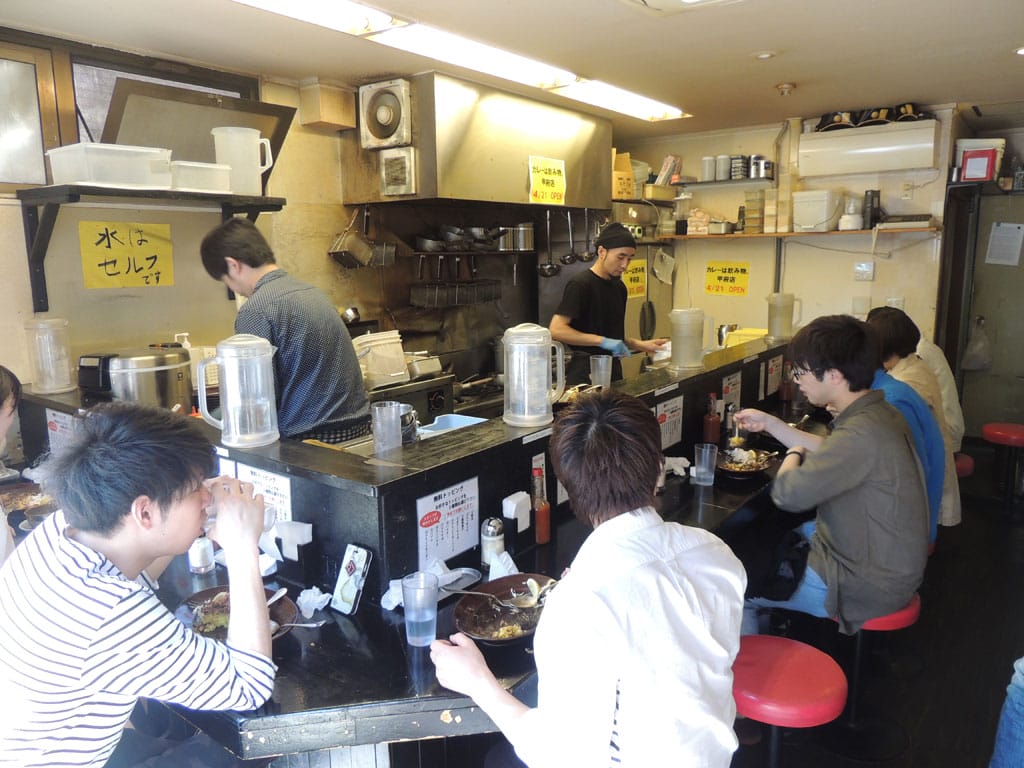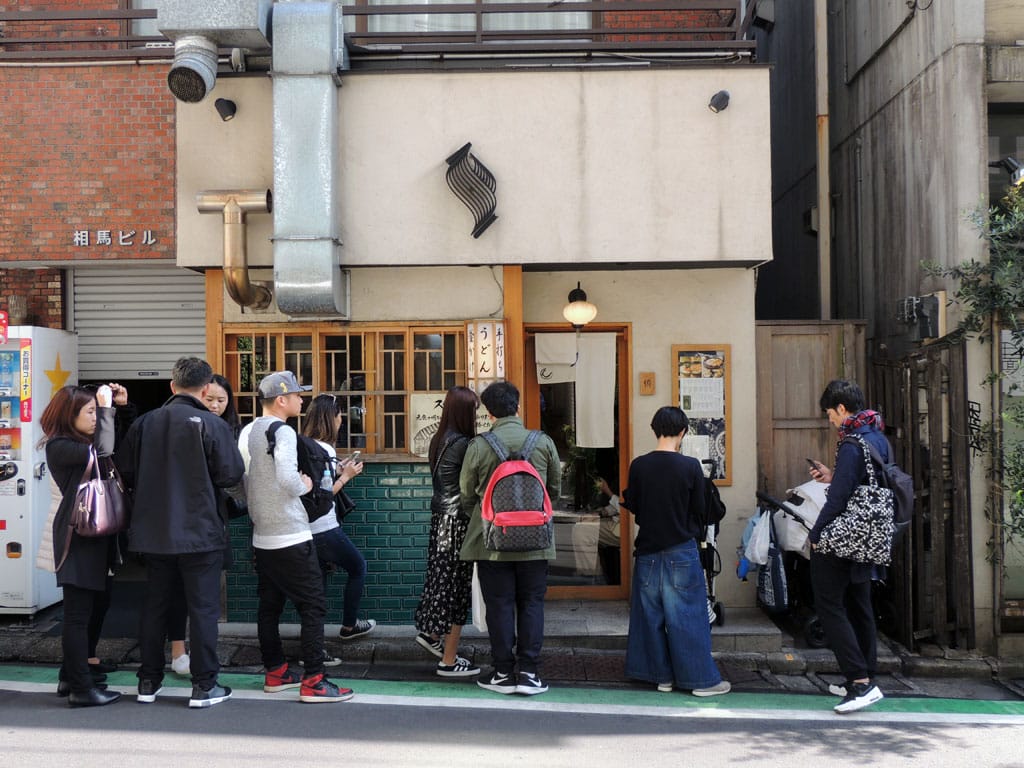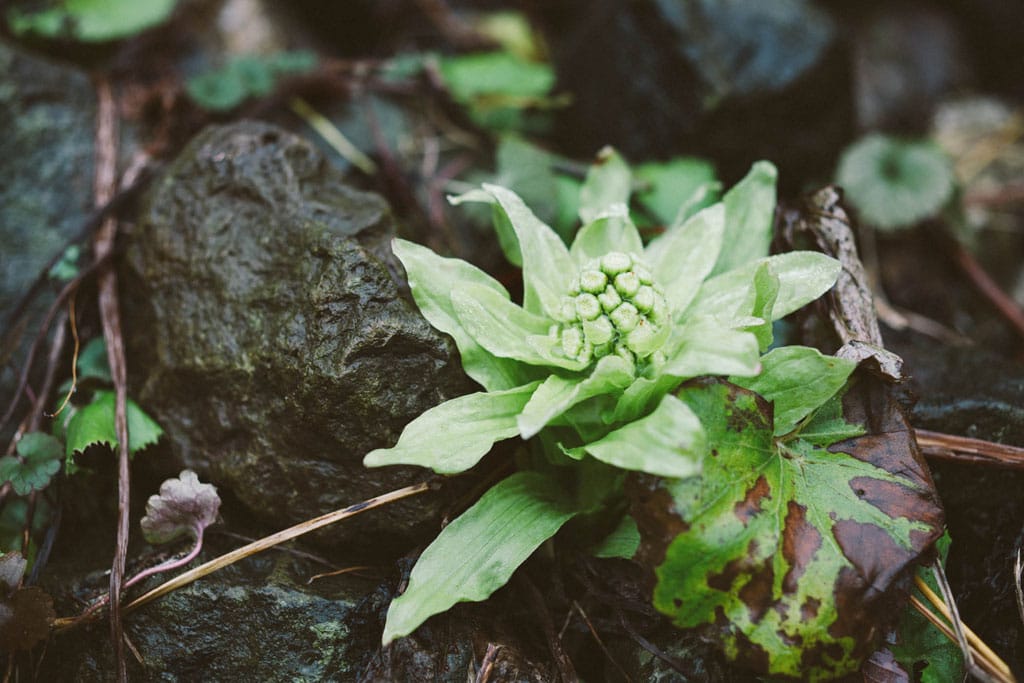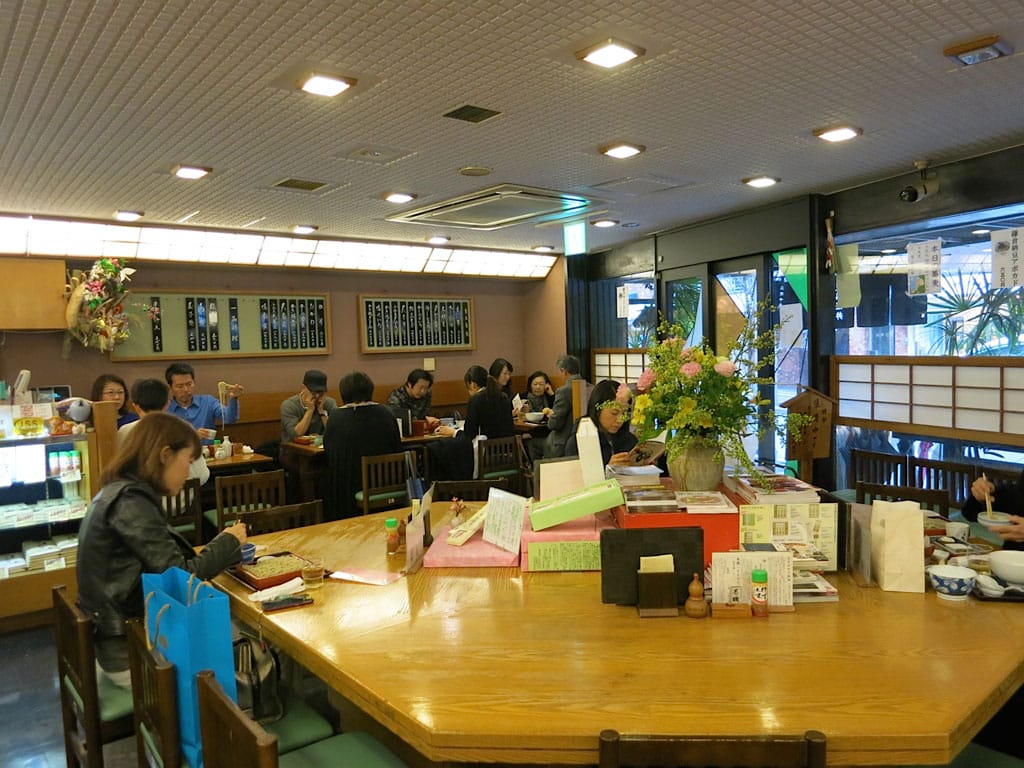This was a year of culinary highs for sure, ranging from the ridiculous to the seriously sublime.
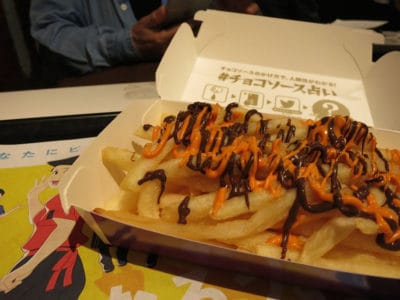 McDonald’s Choco-Pumpkin fries
McDonald’s Choco-Pumpkin fries
Yes, you’ve read correctly. While out researching some serious Halloween treats I stumbled on a Mickey D’s seasonal specialty for Japan – Choco-Pumpkin fries. Not only did a picture of it on the menu look pretty awful, the thought of neither salt nor ketchup on my spuds seemed so wrong. And yet it turned out to be a truly impressive surprise. The standard fries at McDonald’s – or, as it’s known in Japan, makudonarudo – came with a packet of chocolate syrup and a packet of pumpkin syrup that you swirl over them yourself. Although I had planned a mere investigative taste, I wound up finishing the whole thing. Full disclosure: I went back and had more! I’m not sure if the pumpkin flavor will remain on the menu, but the choco fries seem to be a keeper.
Sake-flavored Kit Kats
This must be the best version of having your cake and eating it that I’ve ever encountered. KitKats are so popular in Japan that there are 300 flavors and counting. Kitto katsu means “surely win” in Japanese, and the KitKat flavors developed by Nestle for the Japanese market are always culinary winners. While I’ve always enjoyed the matcha (green tea) and wasabi flavors, 2016 brought the introduction of sake KitKats, and the world became a better place. The white-chocolate-covered wafers are infused with 0.8 percent real sake, creating an umami experience that surpasses all other KitKat indulgences and leaves a slight sake aftertaste. They’re available at supermarkets and souvenir stands.
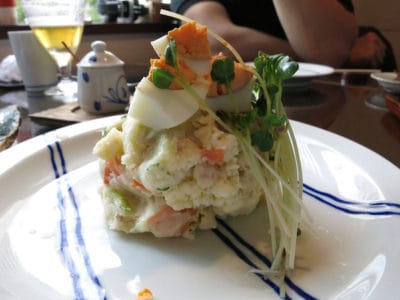 Muho Soba
Muho Soba
I tend to choose my favorite soba noodle shops by the “add ons” – the small plates available as side dishes. At Muho Soba I discovered the ultimate mound of potato salad that keeps me up at night dreaming of more and keeps me coming back. Muho Soba is a mom-and-pop venture in a tastefully modern building, with antique furniture and attractive artwork. The dish, laced with Japanese-style mayonnaise that uses rice vinegar instead of distilled vinegar and only egg yolks instead of whole eggs, was studded with carrots and crispy Japanese cucumbers. Then this swoon-worthy mound of creamy potato salad is topped with a slightly undercooked hard-boiled egg and a swath of daikon sprouts to complete the dish.
Gempinfugu
Fugu, or blowfish, is an acquired taste famous for its delicate flavor and its reputation for being deadly when not prepared correctly. The chefs at Kichijoji’s Gempinfugu are fully licensed by the Japanese government to serve the fish and have years of experience behind them. It has been a pleasure watching our Culinary Backstreets walk guests enjoy gorgeous plates of fugu sashimi, washing it down with atsukan, or warm sake, prepared in one of our favorite ways. Fugu fins, or hire, are brought to the table soaking in a glass of hot sake. The fin is taken out of the sake and lit on fire for a few seconds and then dropped back in the glass, infusing the beverage with a unique aroma and pungently sweet taste. Hirezake is always a highlight of a winter meal and rarely served outside of Japan. Gempinfugu does it perfectly.
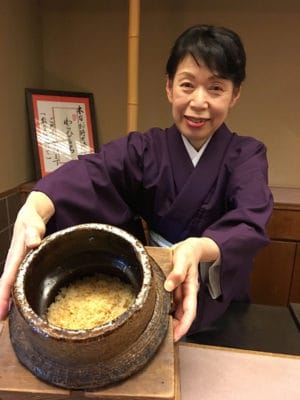 Gosho Ungetsu
Gosho Ungetsu
A great pleasure of spending time in Kyoto is sampling the local cuisine. This past spring I stopped at Gosho Ungetsu for a lunchtime kaiseki meal in this amazing restaurant that features a woman chef. One of the highlights was a dish of a seasonal fish called kamo, which was lightly poached and served with a plum sauce, shiso flowers, fava beans and wasabi. It was not only a feast for the eyes, but the many flavors and how they all harmonized created many novel sensations. Topping off the long parade of the meal’s delicacies was the traditional rice course of perfectly cooked rice done in a stone pot over a wood fire. This is to regular rice what wood-fired pizza would be to a frozen pizza baked in a toaster oven. The texture is a bit firmer than the usual Japanese rice, the aroma a bit more intense, and the bottom of the pan has a crunchy crust called okoge that most Japanese prize as a delicacy. Served with a red miso soup and pickles, it made me wish I could start the meal all over again. The meal was accompanied by sake served with spring leaves in a cedar basin – the most gorgeous presentation of 2016.
— Fran Kuzui
In a futile effort to try and wrap my head around Tokyo’s vast culinary landscape, I eat out for nearly every meal. This obviously gets expensive, so I often focus on the so-called “B-kyū,” or “B-class” gourmet eateries. The trend of downhome, cut-rate meals without the snobbery associated with more high-end, gastronomic restaurants in Tokyo has been ascendant for years. It’s not surprising when you consider that Tokyo has more Michelin-starred restaurants than any other city in the world, but the vast majority of the population can’t afford to dine at them. Two of my three picks for this year’s Best Bites come from this category.
Karē wa Nomimono
This one-of-a-kind curry shop is about as unpretentious as it gets in Tokyo. Even still, word of their unique recipe and gut-busting portions has spread from the cramped shop in Tokyo’s unrefined northwestern Ikebukuro neighborhood. Local college students and day laborers line up alongside business execs and gastronomes for a short stint at the crowded counter. Once inside, talk radio blares over the sound of the kitchen at work. It’s a two-man operation, and the chefs run a tight ship. There are only two menu options on the ticket vending machine that diners order from: a roux-based “black” curry modified from the traditional Japanese style, and a tomato-based “red” curry. The black is the most popular, but in either case you can customize your plate with three toppings chosen from a list of ten plastered prominently on the wall. I almost always get the black curry topped with potato salad, corn mayo and fried onions (numbers 4, 8 and 10). Each hefty plate comes heaped with jasmine rice, slow-cooked hunks of tender pork and stewed daikon swimming in a rich curry roux.
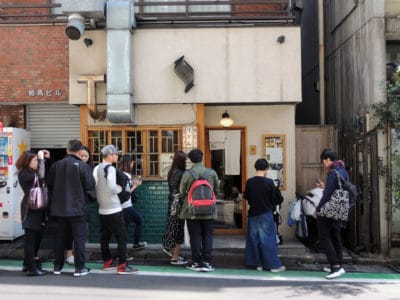 Udon Shin
Udon Shin
I discovered Udon Shin on the southwest fringes of Shinjuku very much by accident at the end of a night on the town. I’d noticed the line out front when walking to the bar next door and upon leaving was happy to slip in for the very last order they took that night. This timing would prove fateful, as I’ve never had better udon before or since.
Owner and chef Shinji Narahara fell in love with udon at an early age. Training in other udon restaurants, he honed his own recipe for a low-flour dough that he cuts his own unique way. The results are exquisitely chewy and improbably delicious, but the noodles are only half of it. The dashi broth made from katsuoboshi (dried skipjack tuna) is smoky and subtle, perfectly complementing the noodles swimming inside. Still, Narahara’s best innovation is his carbonara udon, the greatest Italian-Japanese fusion since Super Mario. The dish is served with raw egg, butter, fresh black pepper, parmesan cheese and a mouth-watering slab of tempura-fried back bacon. Just thinking about it makes us hungry.
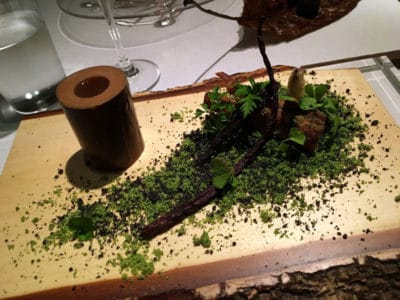 Narisawa
Narisawa
As ubiquitous as B-class gourmet has become of late, A-class will always keep its place at the top. One can’t live in Tokyo without dabbling in the world of fine-dining a time or two, and anyone who has splurged at Narisawa understands why it’s continually rated the best restaurant in Japan.
Earlier this year Narisawa served a menu based on the theme of satoyama, a term that refers to the narrow boundary between mountains and flat, arable land. Chef Yoshihiro Narisawa brought his culinary virtuosity to every dish, from the soft-shelled turtle to the buds of foraged butterbur. The most memorable course, however, was the very first, titled “Satoyama Scenery and Essence of the Forest,” designed to set the tone for the rest of the meal. The dish was a miniature forest landscape of burdock and edible moss with a palate cleanser of cedar-infused water, as beautiful to look at is it was good to eat.
Dinner for two at Narisawa will set you back as much as a flight to Tokyo, but we can’t think of a better reason to visit Japan’s capital than the endless world-class meals that the city has to offer.
— Davey Young
 November 18, 2016 Udon Shin
November 18, 2016 Udon Shin
Anticipating a line, we arrived ahead of our appetite, but the slightly acrid smell of […] Posted in Tokyo May 2, 2023 Spring Gone Wild
May 2, 2023 Spring Gone Wild
One of the great joys of spring in Japan is anticipating the appearance of sansai, or […] Posted in Tokyo July 15, 2021 Sarashina Horii Soba
July 15, 2021 Sarashina Horii Soba
How thrilling to know it’s possible to reach far back into Japan’s gastronomic past […] Posted in Tokyo
Published on December 05, 2016
Related stories
November 18, 2016
TokyoAnticipating a line, we arrived ahead of our appetite, but the slightly acrid smell of fresh dashi wafting over the street hurried our hunger. Tucked behind a handful of confounding corners southwest of Shinjuku Station in a mixed-use neighborhood of apartments, shops and offices, Udon Shin has consistently ranked among the best udon restaurants in…
May 2, 2023
TokyoOne of the great joys of spring in Japan is anticipating the appearance of sansai, or mountain vegetables. When cherry blossoms begin to flutter on warming breezes, hikers take to the hills to forage for the first wild edibles. Supermarkets mount special displays of packaged (and unfortunately often hot-house-raised) young sprouted leaves, shoots and tubers.…
July 15, 2021
TokyoHow thrilling to know it’s possible to reach far back into Japan’s gastronomic past merely by visiting Azabu Juban’s Sarashina Horii Soba for a bit of “living history” in the form of a pleasantly simple meal. The Sarashina cooking lineage stretches back over 200 years and is always evident in the shimmering, high-quality plates of…







































